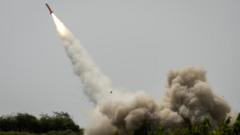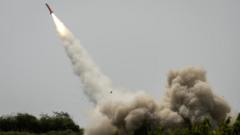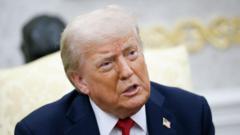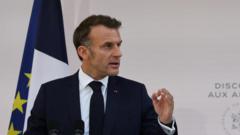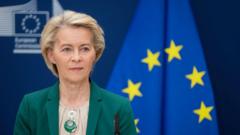In response to President Trump's threats of tariffs and sanctions against Russia, the Russian stock market has reacted positively, indicating a sense of relief rather than panic. Trump’s tougher stance does signal a shift in US policy, as he seeks to compel Russia to negotiate an end to the Ukraine war. However, the Kremlin remains firm in its terms, complicating potential resolutions.
US Tariff Threat Spurs Mixed Reactions in Russia as Stock Market Rises
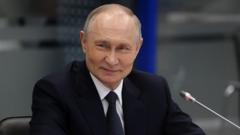
US Tariff Threat Spurs Mixed Reactions in Russia as Stock Market Rises
While new sanctions loom from the US over the Ukraine conflict, Russia's markets show resilience, highlighting differing perceptions of the situation.
The article text:
Amid escalating tensions, a controversial tariff threat from the United States has raised eyebrows, yet the Russian stock market responded with unexpected optimism. Reflecting Moscow’s cautious anticipation of further sanctions, President Trump’s recent pronouncements appear to be more of a signal for strategic maneuvering than an immediate cause for alarm for the Kremlin.
On Monday, Trump emphasized his commitment to support Ukraine by announcing new arms shipments financed by European allies while reiterating his stance on imposing fresh tariffs on Russia if negotiations to resolve the Ukraine conflict do not progress meaningfully within 50 days. Reports from Russia, including coverage by Moskovsky Komsomolets, suggested a foreboding outlook regarding the potential for confrontation.
However, the immediate market response in Russia was a notable 2.7% increase, suggesting an underlying confidence in the nation's resilience against external pressures. Analysts observe this reaction as indicative of Moscow's preparedness for tougher sanctions—a possible preemptive measure against anticipated US actions.
The timeline set for tariffs to take effect offers a window for the Kremlin to devise counterstrategies, extending their ability to engage in negotiations without immediate pressure. Russia's emphasis in discussions has consistently highlighted the significance of addressing what it perceives as existential security threats posed by NATO and Western military aid to Ukraine, complicating avenues for diplomatic resolution.
While the Trump administration navigates its policy toward Moscow, seeking an end to the ongoing war in Ukraine remains paramount in its foreign agenda, juxtaposed against Russia's layered demands anchored in its own narrative of security and peace terms. This "Yes, but…" strategy from the Kremlin has, until now, allowed it to maintain a degree of stability while the conflict lingers.
The dynamic between the two nations is fraught as both seek to reaffirm their positions. Trump’s dealings reflect increasing frustration over Putin's reticence in brokering a peace deal and a tougher approach to sanctions could reflect that irritation. At the same time, observers in Russia note a growing discontent with Trump’s administration, responding critically to his tactics and rhetoric.
Amid ongoing skirmishes and a complex battlefield dynamic in Ukraine, both leaders appear to be locked in a stalemate where mutual understanding remains elusive, and geopolitical intricacies continue to play a significant role in shaping their strategies and responses. The unfolding situation underscores the complex interplay of military, economic, and diplomatic factors that will likely shape the future trajectory of US-Russia relations.
Amid escalating tensions, a controversial tariff threat from the United States has raised eyebrows, yet the Russian stock market responded with unexpected optimism. Reflecting Moscow’s cautious anticipation of further sanctions, President Trump’s recent pronouncements appear to be more of a signal for strategic maneuvering than an immediate cause for alarm for the Kremlin.
On Monday, Trump emphasized his commitment to support Ukraine by announcing new arms shipments financed by European allies while reiterating his stance on imposing fresh tariffs on Russia if negotiations to resolve the Ukraine conflict do not progress meaningfully within 50 days. Reports from Russia, including coverage by Moskovsky Komsomolets, suggested a foreboding outlook regarding the potential for confrontation.
However, the immediate market response in Russia was a notable 2.7% increase, suggesting an underlying confidence in the nation's resilience against external pressures. Analysts observe this reaction as indicative of Moscow's preparedness for tougher sanctions—a possible preemptive measure against anticipated US actions.
The timeline set for tariffs to take effect offers a window for the Kremlin to devise counterstrategies, extending their ability to engage in negotiations without immediate pressure. Russia's emphasis in discussions has consistently highlighted the significance of addressing what it perceives as existential security threats posed by NATO and Western military aid to Ukraine, complicating avenues for diplomatic resolution.
While the Trump administration navigates its policy toward Moscow, seeking an end to the ongoing war in Ukraine remains paramount in its foreign agenda, juxtaposed against Russia's layered demands anchored in its own narrative of security and peace terms. This "Yes, but…" strategy from the Kremlin has, until now, allowed it to maintain a degree of stability while the conflict lingers.
The dynamic between the two nations is fraught as both seek to reaffirm their positions. Trump’s dealings reflect increasing frustration over Putin's reticence in brokering a peace deal and a tougher approach to sanctions could reflect that irritation. At the same time, observers in Russia note a growing discontent with Trump’s administration, responding critically to his tactics and rhetoric.
Amid ongoing skirmishes and a complex battlefield dynamic in Ukraine, both leaders appear to be locked in a stalemate where mutual understanding remains elusive, and geopolitical intricacies continue to play a significant role in shaping their strategies and responses. The unfolding situation underscores the complex interplay of military, economic, and diplomatic factors that will likely shape the future trajectory of US-Russia relations.


